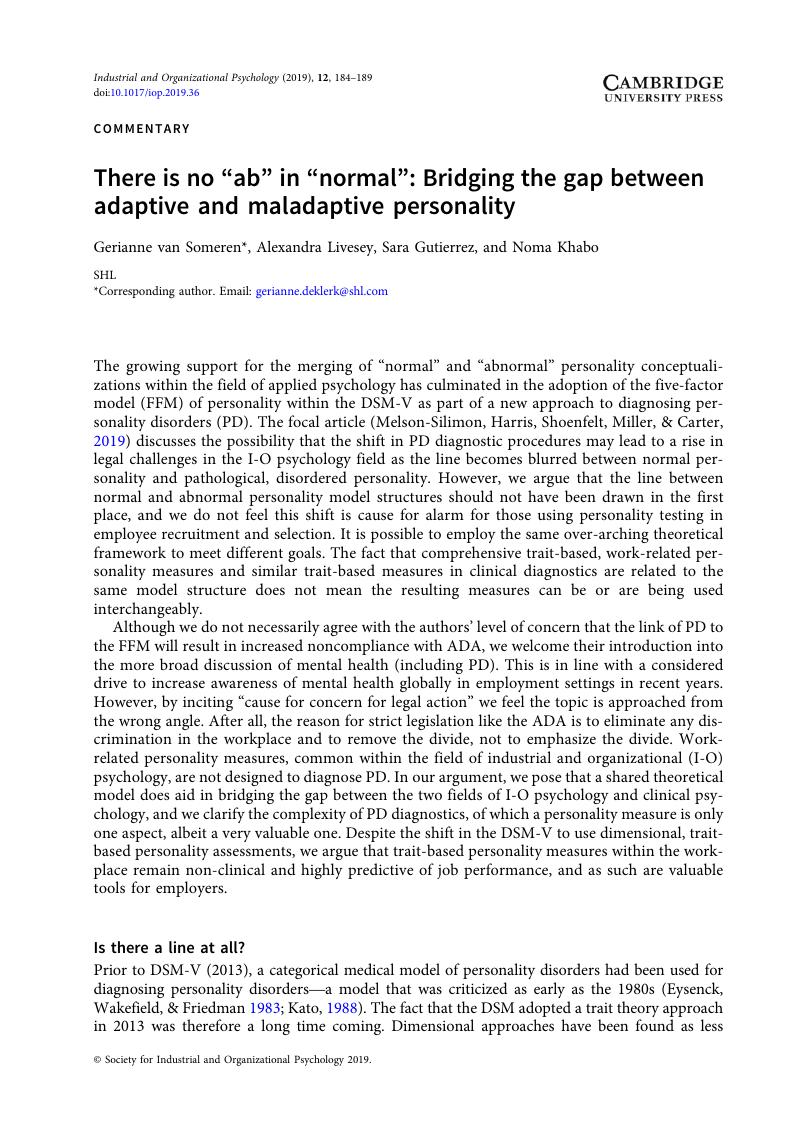No CrossRef data available.
Article contents
There is no “ab” in “normal”: Bridging the gap between adaptive and maladaptive personality
Published online by Cambridge University Press: 01 August 2019
Abstract
An abstract is not available for this content so a preview has been provided. Please use the Get access link above for information on how to access this content.

- Type
- Commentaries
- Information
- Copyright
- © Society for Industrial and Organizational Psychology 2019
References
American Educational Research Association (AERA). (2014). Standards for educational and psychological testing. Washington, DC: Author.Google Scholar
Barrick, M. R., Mount, M. K., & Judge, T. A. (2001). Personality and performance at the beginning of the new millennium: What do we know and where do we go next? International Journal of Selection and Assessment, 9(1–2), 9–30.CrossRefGoogle Scholar
Bartram, D. (2005). The great eight competencies: A criterion-centric approach to validation. Journal of Applied Psychology, 90, 1185–1203.CrossRefGoogle ScholarPubMed
Butcher, J. N., Graham, J. R., Ben-Porath, Y. S., Tellegen, A., Dahlstrom, W. G., & Kaemmer, B. (2001). MMPI-2 (Minnesota Multiphasic Personality Inventory-2): Manual for administration, scoring, and interpretation, revised edition. Minneapolis, MN: University of Minnesota Press.CrossRefGoogle Scholar
Clarke, S., & Robertson, I. (2008). An examination of the role of personality in work accidents using meta-analysis. Applied Psychology: An International Review, 57, 94–108.CrossRefGoogle Scholar
Costa, P. T. Jr., & McCrae, R. R. (1992). Four ways five factors are basic. Personality and Individual Differences, 13(6), 653–665.CrossRefGoogle Scholar
Equal Employment Opportunity Commission, Civil Service Commission, Department of Labor & Department of Justice. (1978). Uniform guidelines on employee selection procedures. Washington, DC: Author.Google Scholar
Eysenck, H. J., Wakefield, J. A. Jr, & Friedman, A. F. (1983). Diagnosis and clinical assessment: The DSM-III. Annual Review of Psychology, 34(1), 167–193.CrossRefGoogle ScholarPubMed
International Test Commission. (2014). ITC guidelines on quality control in scoring, test analysis, and reporting of test scores. International Journal of Testing, 14(3), 195–217.CrossRefGoogle Scholar
Judge, T. A., & LePine, J. A. (2007). The bright and dark sides of personality: Implications for personnel selection in individual and team contexts. In Langan-Fox, J., Cooper, C. L., & Klimoski, R. J. (Eds.), Research companion to the dysfunctional workplace: Management challenges and symptoms (pp. 332–355). Cheltenham, UK: Edward Elgar.Google Scholar
Kato, M. (1988). Issues on diagnosing and classifying personality disorders. In Mezzich, J. E. & von Cranach, M. (Eds.), International classification in psychiatry: Unity and diversity (pp. 166–174). New York, NY: Cambridge University Press.Google Scholar
Markon, K. E., Krueger, R. F., & Watson, D. (2005). Delineating the structure of normal and abnormal personality: An integrative hierarchical approach. Journal of Personality and Social Psychology, 88(1), 139–157.CrossRefGoogle ScholarPubMed
McCrae, R. R., & Costa, P. T. Jr. (2008). The five-factor theory of personality. In John, O. P., Robins, R. W., & Pervin, L. A. (Eds.), Handbook of personality: Theory and research (pp. 159–181). New York, NY: Guilford Press.Google Scholar
Melson-Silimon, A., Harris, A. M., Shoenfelt, E. L., Miller, J. D., & Carter, N. T. (2019). Personality testing and the Americans with Disabilities Act: Cause for concern as normal and abnormal personality models are integrated. Industrial and Organizational Psychology: Perspectives on Science and Practice, 12(2), 119–132.Google Scholar
Penney, L. M., & Spector, P. E. (2005). Job stress, incivility, and counterproductive work behavior (CWB): The moderating role of negative affectivity. Journal of Organizational Behavior, 26(7), 777–796.CrossRefGoogle Scholar
Society for Industrial and Organizational Psychology. (2018). Principles for the validation and use of personnel selection procedures. Bowling Green, OH: Author.Google Scholar
Trull, T. J., Widiger, T. A., & Guthrie, P. (1990). Categorical versus dimensional status of borderline personality disorder. Journal of Abnormal Psychology, 99(1), 40–48.CrossRefGoogle ScholarPubMed
Widiger, T. A. (2009). Neuroticism. In Leary, M. R. and Hoyle, R. H. (Eds.), Handbook of individual differences in social behavior (pp. 129–146). New York, NY: Guilford.Google Scholar
Widiger, T. A., Costa, P. T., Gore, W. L., & Crego, C. (2002). Five-factor model personality disorder research. In Widiger, T. A. & Costa, P. T. Jr. (Eds.), Personality disorders and the five-factor model of personality (2nd ed., pp. 59–88). Washington, DC: American Psychological Association.CrossRefGoogle Scholar
Widiger, T. A., & Frances, A. J. (1994). Toward a dimensional model for the personality disorders. In Costa, P. T. Jr. & Widiger, T. A. (Eds.), Personality disorders and the five-factor model of personality (pp. 19–39). Washington, DC: American Psychological Association.CrossRefGoogle Scholar
Witt, L. A. (2002). The interactive effects of extraversion and conscientiousness on performance. Journal of Management,28, 835–851.CrossRefGoogle Scholar


